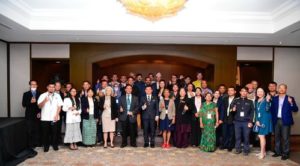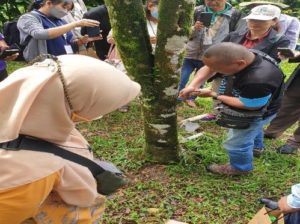Towards sustainability for one of the world’s most valuable essential oils

Validation Workshop on Agarwood Report, 20-22 June 2022, Kuala Lumpur, Malaysia
A meeting of experts in Malaysia has been looking at ways to make the trade in one of the world’s most precious essential oils more sustainable. Agarwood and the essential [Agar] oil that comes from it are used for medicine, cosmetics, incense, art and interior design. It was mentioned in the Sanskrit Vedas from 1,400 BCE as a product of ‘wealth and luxury’ and is supposed to have been used to anoint the body of Christ and in the cremation ceremony of the Buddha. One liter of oil can sell for as much as US$50,000 and the value of the Agarwood industry is estimated to be at least USD 30 billion annually.
The workshop, that’s just concluded in Malaysia, brought together governments and experts to look at the methods of conserving trees in the wild and also the promotion of artificially propagated Agarwood to help with the overall sustainability of the species.
The Aquilaria species of trees is native to southeast Asia. The sweet-smelling wood and oils that it produces only occur as a result of a fungal infection in the heartwood of the tree. As a defense again the fungus, the tree produces a resin that infuses the heartwood, producing the highly prized agarwood. It’s thought that this process only occurs in around 2 percent of trees in the wild. The high price that agarwood and the oils can command has led to unsustainable harvesting and illegal logging, so much so that the global wild population of Aquilaria trees has dropped around 80% in little more than a century.
Many species of Aquilaria are now critically endangered and listed in CITES Appendix II, which strictly regulates their international trade.
This year, the meeting of the Conference of the Parties to CITES, or the Convention on International Trade in Endangered Species of Wild Fauna and Flora, is being held in Panama in November. It will look at the sustainability of the Aquilaria trees and consider how better to conserve the species. The CITES Tree Species Project (CTSP) in partnership with the International Tropical Timber Organization (ITTO), has also been heavily involved in looking at and advising on how best to manage Aquilaria trees across southeast Asia. A comprehensive study and the report from the Malaysian workshop will feed into this process.
In Kuala Lumpur, there were 50 representatives (including 10 virtual participants) from range and importing States with experiences of agarwood management in the wild or in plantations. They discussed how injecting trees with the necessary fungus can increase the percentage that produce agarwood from around 2% to nearly 100%. This means that fewer trees need to be cut down to produce the same amount of agarwood and avoids the huge waste of trees, harvested but found to be without any oil and therefore virtually worthless.
They discussed how injecting trees with the necessary fungus can increase the percentage that produce agarwood from around 2% to nearly 100%. This means that fewer trees need to be cut down to produce the same amount of agarwood and avoids the huge waste of trees, harvested but found to be without any oil and therefore virtually worthless.
Other conservation options could include trying to better understand and use traditional techniques for harvesting trees. There is evidence that local and indigenous communities may be able to detect which trees contain agarwood oils using the different sounds made by ‘knocking’ on the trunks of the trees. Another technique could be to try to cut out the oil-bearing, valuable part of the tree, without cutting the whole tree down.
The global agarwood industry is estimated to be worth up to US$30 billion, however there are continued concerns for the sustainability of the species and the continued illegal wild harvesting and for these reasons, the CITES World Wildlife Conference in November will be looking at ways in which international trade regulations can contribute to the continued viability of the Aquilaria species.
The final agarwood report produced by ITTO, along with presentations of range States and the workshop report will be available at / as soon as it’s completed.

